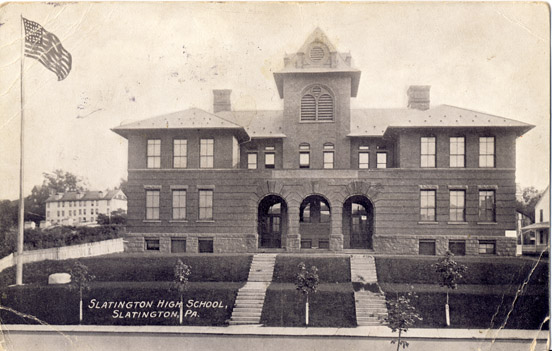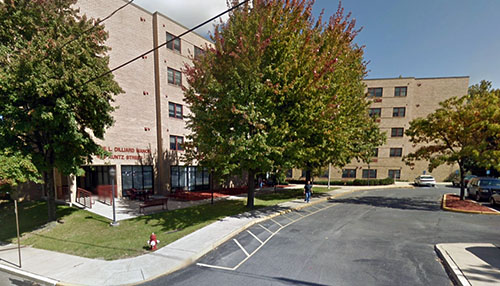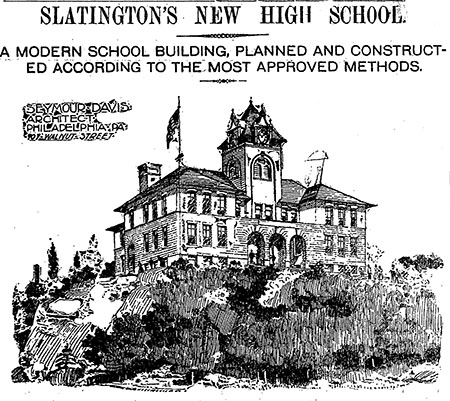After deciding sometime in 1896 on the need for a high school in Slatington, in May 1897 the school board reviewed possible plans with architect Seymour Davis (1869-1923), 907 Walnut Street, Philadelphia. Davis, with his brother Paul, was responsible for many buildings in eastern and central Pennsylvania, including the old Allentown Hospital (on 17th Street) and the Carnegie Building at Penn State University.
The school board agreed to a proposed completion date of 1 October 1897. The general contract was awarded to L. H. Focht of Reading, and the cornerstone was laid in July 1897 in an imposing ceremony led by the Grand Lodge of the Most Ancient and Honorable Fraternity of Free and Accepted Masons in Pennsylvania.
The school did open in October 1897. The contract for construction was $13,625 plus sub-contracts for heating, plumbing, blackboards, etc. @ 4,000 for a total cost of $17,625. The building was 96 feet across the front with a depth of 82 feet. The first floor had four school rooms and a teacher’s room. The second floor had two school rooms, two recitation rooms and an assembly room with a capacity of 450. Each school room came equipped with a cloak room, teacher’s closet and water access. There were two flights of stairs at each end of the building. The basement had the heating equipment and toilets. The building was constructed of red brick atop a foundation of Hummelstown brown stone with a blue slate roof.
The headline in The Slatington News on 23 February 1917 read: FIRE DESTROYS SLATINGTON’S HIGH SCHOOL BUILDING.
A little before 2 PM on Tuesday afternoon, 20 February, a fire was discovered in the school’s basement storeroom. Smoke quickly filled the building as the three hundred students in grades 5-12 were dismissed. Fire companies were called to the scene, but it was too late. By dusk the school was nothing more than a smoldering ruin with only the outside walls surviving.
While work continued on a new high school which was being built nearby on Main Street, the displaced students were scattered into the town’s churches.
In early April 1917 the school board hired Edward Zartman Scholl (1977-1962) to rebuild the ruined building. He was also the architect in charge of the new high school building. Scholl, based at 31 South Sixth Street in Reading, PA, had designed several schools in the Reading area.
In June 1918, the general contract was awarded to F. Handwerk’s Sons for $13,049, and by February 1919, less than two years after the fire, the old high school building had been re-occupied with the elementary and middle grades.
In February 1920, the re-built, old high school was named the Lincoln Building, and the third ward school was named the Roosevelt Building.

Earlier view of the Slatington High School circa 1910
With the opening of a new Slatington elementary school (1201 Shadow Oaks Lane) in the fall of 1973, the Lincoln elementary building was no longer needed, and in the summer of 1975 the building was razed by Marvin C. Miller Demolition of Birdsboro, Berks County.
Then in late 1980 the Lincoln property and the neighboring Smith Hall were sold by the Northern Lehigh School District board to the Lehigh County Housing Authority for $75,000. The authority planned to erect a 75-unit apartment building for the elderly on the site of the former school.
In July 1982, the razing of the 45-year-old Smith Hall by Zak Demolition of Bethlehem began. The Morning Call reported that “The acquisition of Smith Hall was not necessary to construct the apartment building, according to LCHA Executive Director John Seitz, but the district preferred to sell the two properties together.”
Trout Creek Manor at 425 Kuntz Street was dedicated in November 1982. It contained seventy-five, one-bedroom apartments designed for the elderly and handicapped. In 2001, it was renamed George L. Dillard Manor in honor of Dillard’s (1936-2007) service with the Lehigh County Housing Authority.
As close as I lived to the Lincoln Building, and despite spending time there in elementary school, and then later playing “strikeout” on the Lincoln playground with my brother for years, it is strange that I have absolutely no recollection of the demolition of the building back in 1975 even though I was in high school at the time.
The same goes for the destruction of Smith Hall which happened in 1982 just after I had graduated from college.
These were both fine buildings, and it seems to me unfortunate that there was no real available path to ensure their survival.
For kindergarden through sixth grade, I was in the Lincoln building with its wood floors, large windows, and coat closets in the rooms.
One thing that I remember about the building is that there were "Fall Out" shelter signs over the entrances, and there were supplies stored in the basement in case of nuclear attack. Of course, we dilligently practices our air raid drills when the air raid signal sounded. We'd sit cross-legged in the hall with hands behind our head and head bowed toward our knees.
When I was in the elementary school, we no longer used the front entrance to the building. Instead there were entrances on the side and in the back. The kindergarten room had its own separate entrance onto the playground.

Trout Creek Manor on the former site of the first Slatington High School (Lincoln building), 2023
